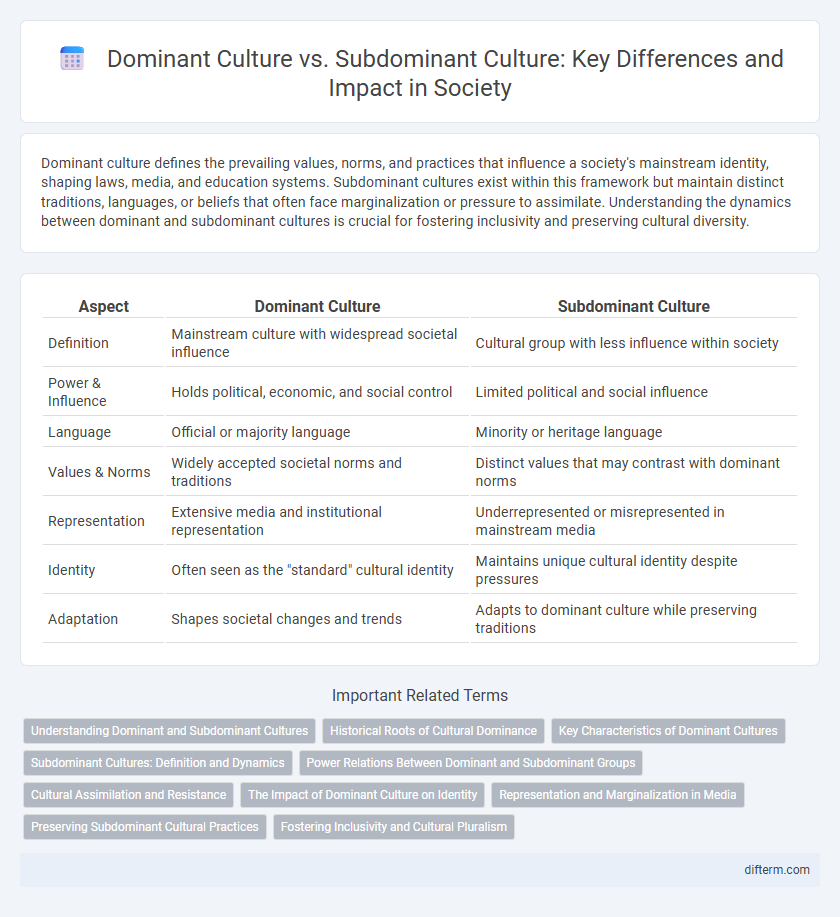Dominant culture defines the prevailing values, norms, and practices that influence a society's mainstream identity, shaping laws, media, and education systems. Subdominant cultures exist within this framework but maintain distinct traditions, languages, or beliefs that often face marginalization or pressure to assimilate. Understanding the dynamics between dominant and subdominant cultures is crucial for fostering inclusivity and preserving cultural diversity.
Table of Comparison
| Aspect | Dominant Culture | Subdominant Culture |
|---|---|---|
| Definition | Mainstream culture with widespread societal influence | Cultural group with less influence within society |
| Power & Influence | Holds political, economic, and social control | Limited political and social influence |
| Language | Official or majority language | Minority or heritage language |
| Values & Norms | Widely accepted societal norms and traditions | Distinct values that may contrast with dominant norms |
| Representation | Extensive media and institutional representation | Underrepresented or misrepresented in mainstream media |
| Identity | Often seen as the "standard" cultural identity | Maintains unique cultural identity despite pressures |
| Adaptation | Shapes societal changes and trends | Adapts to dominant culture while preserving traditions |
Understanding Dominant and Subdominant Cultures
Dominant cultures shape societal norms, values, and institutions, often defining mainstream beliefs and behaviors within a community or country. Subdominant cultures, by contrast, maintain distinct traditions, languages, and practices that coexist alongside dominant culture but face challenges in gaining widespread recognition or influence. Understanding the dynamic interaction between dominant and subdominant cultures reveals how power, identity, and social integration influence cultural diversity and inclusion.
Historical Roots of Cultural Dominance
Historical roots of cultural dominance often stem from colonialism, economic control, and political power, where dominant cultures impose language, customs, and values on subdominant groups. These dominant cultures shape social norms and institutional frameworks, marginalizing indigenous traditions and creating lasting power imbalances. The persistence of dominant cultural narratives influences identity formation and access to resources for subdominant cultures.
Key Characteristics of Dominant Cultures
Dominant cultures command societal influence through widespread acceptance of values, norms, and language that shape institutions like education, governance, and media. These cultures promote mainstream beliefs, often marginalizing subdominant groups by establishing social, economic, and political power dynamics. Key characteristics include normative conformity, cultural homogenization, and control over resource distribution, reinforcing their dominance within the social hierarchy.
Subdominant Cultures: Definition and Dynamics
Subdominant cultures refer to smaller, less influential cultural groups within a dominant society that preserve distinct traditions, languages, and social norms. These cultures often navigate complex power dynamics, balancing cultural expression with pressures of assimilation and marginalization. Understanding subdominant cultures involves examining their resilience, contributions to pluralism, and the challenges they face in maintaining identity amidst dominant cultural narratives.
Power Relations Between Dominant and Subdominant Groups
Power relations between dominant and subdominant cultures are characterized by the dominant group's control over resources, social norms, and institutional structures that perpetuate their authority and influence. Subdominant cultures often experience marginalization, limited access to opportunities, and cultural suppression as a result of systemic inequalities enforced by dominant societal forces. This dynamic influences identity formation, social cohesion, and intergroup interactions within multicultural societies.
Cultural Assimilation and Resistance
Cultural assimilation often occurs when a subdominant culture adopts the dominant culture's norms, values, and practices to gain social acceptance or economic advantages. Resistance arises as subdominant groups seek to preserve their unique cultural identity, customs, language, and traditions against pressures to conform. This dynamic interplay impacts multicultural societies by shaping social cohesion, identity politics, and cultural diversity policies.
The Impact of Dominant Culture on Identity
The impact of dominant culture on identity shapes individuals' sense of belonging and self-perception by establishing prevailing norms, values, and language that influence social interactions and personal expression. Subdominant cultures often experience pressure to conform or face marginalization, which can lead to identity conflicts or the blending of cultural traits. This dynamic affects cultural preservation and individual identity formation within multicultural societies.
Representation and Marginalization in Media
Dominant cultures shape mainstream media narratives, resulting in widespread representation that reinforces their values, norms, and identities. Subdominant cultures often experience marginalization through underrepresentation, stereotypical portrayals, or exclusion, limiting their visibility and influence in media landscapes. This imbalance in representation perpetuates social inequalities and affects cultural perceptions, access to resources, and identity validation for marginalized groups.
Preserving Subdominant Cultural Practices
Preserving subdominant cultural practices requires intentional efforts to document, celebrate, and incorporate these traditions within broader societal frameworks that often prioritize dominant cultures. Community-led initiatives, educational programs, and media representation play crucial roles in sustaining linguistic, artistic, and ritualistic elements unique to subdominant groups. Protecting cultural diversity enhances social cohesion and prevents the erasure of marginalized identities within a globalized context.
Fostering Inclusivity and Cultural Pluralism
Fostering inclusivity and cultural pluralism requires recognizing the dominant culture's influence while actively valuing subdominant cultures' unique identities and contributions. Emphasizing equitable representation, cross-cultural dialogue, and adaptive policies supports social cohesion and enriches collective cultural experiences. Institutions play a crucial role in promoting intercultural understanding and dismantling systemic biases that marginalize subdominant groups.
dominant culture vs subdominant culture Infographic

 difterm.com
difterm.com